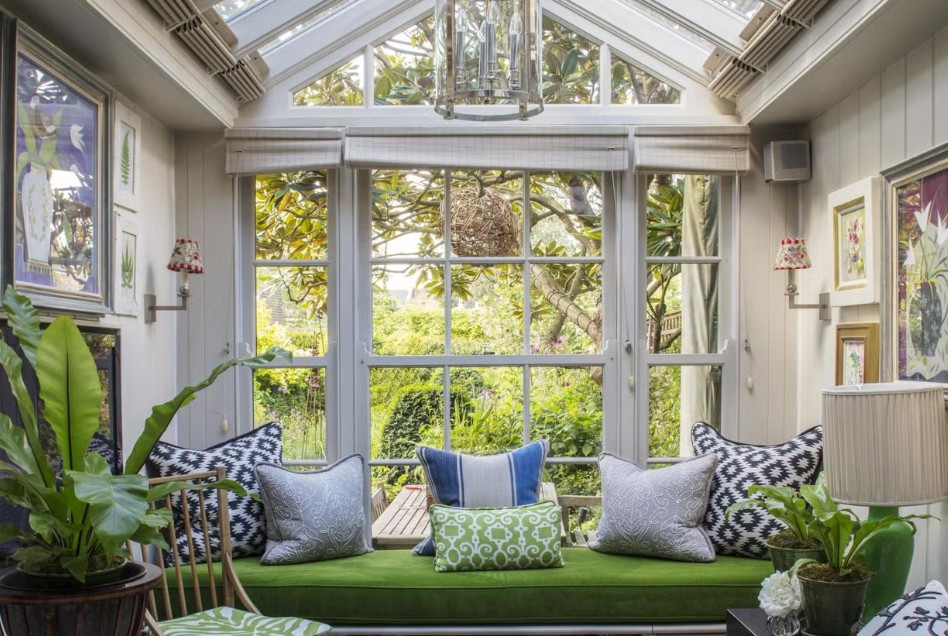Bringing the outdoors in.

Bringing the Outdoors In: Creating
a Natural, Refreshing Interior
In today's fast-paced world, it’s easy to feel
disconnected from nature. However, more and more homeowners and interior
designers are embracing the concept of bringing the outdoors in. This
design philosophy blends the natural world with interior spaces, fostering a
peaceful, rejuvenating atmosphere that helps to reduce stress and improve
overall well-being. Whether you're transforming your living room or creating a
calming home office, here are some inspiring ways to bring the beauty of nature
indoors.
1. Maximize Natural Light
One of the easiest ways to connect your indoor space
with the outdoors is by maximizing natural light. Large windows, glass doors,
and skylights allow natural sunlight to flood into your home, creating a
bright, airy environment that mimics the outdoors. Consider using sheer
curtains or shades that can be easily drawn back to allow for as much light as
possible. Not only does this create a more open, welcoming space, but it also
reduces the need for artificial lighting during the day, helping to lower energy
consumption.
2. Incorporate Indoor Plants
Houseplants are perhaps the most obvious way to
bring nature inside. They purify the air, enhance the aesthetic appeal of any
room, and have been shown to improve mental health. From large leafy ferns to
small succulents, indoor plants are versatile and can suit any décor style. You
can create a small indoor garden, hang planters from the ceiling, or even place
plants on bookshelves or windowsills. The variety of textures and colors in
plants also adds a touch of greenery that balances the indoor space.
3. Natural Materials and Textures
Using natural materials like wood, stone, bamboo,
and rattan is another effective way to incorporate the outdoors into your home.
Hardwood floors, stone countertops, and wooden furniture bring the beauty of
nature indoors while also adding warmth and texture. The organic, rustic feel
of these materials creates a grounded, serene environment. For an
eco-friendlier approach, opt for sustainably sourced materials, which ensure
you're protecting the planet while embracing natural beauty.
4. Nature-Inspired Color Palette
Nature-inspired colors, such as earthy browns, soft
greens, blues, and grays, create a peaceful and harmonious environment. These
colors are reminiscent of landscapes, forests, oceans, and skies, and they can
be used to evoke a calming atmosphere. Consider painting your walls in light
shades of green, tan, or gray, or incorporating accent pillows, rugs, and
throws in deep greens, rich browns, and other natural hues. A color palette
inspired by nature can connect your home to the environment and promote relaxation.
5. Water Features
The calming sound of water is known to reduce stress
and create a tranquil ambiance. Indoor water features, such as fountains or
small indoor ponds, are excellent additions to bring the outdoors in. These
features not only serve as decorative elements but also help create a serene
atmosphere by mimicking the sounds of nature. A tabletop fountain, for example,
can fit seamlessly into a living room or office, adding an element of calm and
refreshing energy.
6. Views of the Outdoors
Whenever possible, design your home with views that
connect you to the surrounding nature. If you're fortunate enough to live in a
scenic area, strategically place seating areas next to windows that offer views
of gardens, trees, or water. Even if you live in a more urban environment,
bringing the outdoors in can mean arranging your space to reflect the outdoors
with views of city parks or using window treatments that open your home to the
view.
7. Nature-Inspired Art and Décor
If you don’t have the luxury of outdoor views,
consider decorating with nature-inspired art. Artwork featuring landscapes,
wildlife, or abstract representations of nature can create a natural vibe
within your home. You can also incorporate décor items made from natural
materials, such as woven baskets, driftwood sculptures, or pottery. These
pieces serve as visual reminders of the outdoors and help make your space feel
connected to nature.
8. Aromatherapy and Nature Scents
To fully immerse your senses in the natural world,
consider incorporating nature-inspired scents into your home. Essential oils,
candles, and diffusers that evoke scents like lavender, pine, cedarwood, or
citrus can transport you to the outdoors. Aromatherapy has been shown to
promote relaxation and mental clarity, so it's a wonderful way to enhance the
connection between your home and nature.
9. Bringing Nature into the Kitchen
The kitchen is another space that can benefit from
nature-inspired touches. Fresh herbs on the windowsill, wooden cutting boards,
and stone countertops can bring natural textures and colors into your cooking
area. You could also try growing your own herbs, such as basil, mint, or
rosemary, to add freshness and fragrance to your cooking routine. These small
additions not only make your kitchen feel more connected to nature but also
bring fresh, flavorful ingredients into your meals.
10. Use of Natural Light & Ventilation
Design your living space in a way that supports
optimal air quality and circulation. This can be achieved through well-placed
windows and ventilated areas to ensure fresh air comes in. Fresh, clean air is
an essential component of creating an outdoor-inspired atmosphere, and
strategically placed windows and open spaces can allow the natural flow of both
light and air into your home.
Conclusion
Bringing the outdoors in is all about creating a
harmonious, balanced environment where nature and design work together to
enhance your daily life. Whether you introduce plants, embrace natural
textures, or focus on maximizing light and ventilation, each element helps to
forge a deeper connection to the natural world. By incorporating natural
materials, colors, and elements, you can turn your home into a sanctuary that
reflects the beauty and tranquility of the outdoors.
